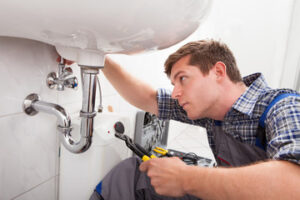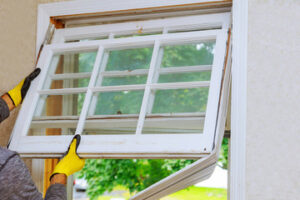A restroom trailer is a great option for weddings, corporate retreats, film sets, and other large events. It’s more comfortable and aesthetically pleasing than smaller portable toilets.
It offers separate men’s and women’s facilities with flushing toilets, privacy dividers, porcelain sink basins, filled antibacterial soap, and hand towel dispensers. It also has a climate control system to keep the insides comfortable. Contact Next Day Potty now!

When you’re hosting a big event, providing comfortable restroom facilities for your guests is a must. While single porta potties can be adequate for some events, others require a little more luxury and comfort. For this purpose, restroom trailers are a perfect solution. Each one includes flushing toilets, running water, and climate control. Unlike traditional portable toilets, these units are ideal for large events that take place in locations without permanent restroom facilities.
These restrooms are a great choice for corporate retreats, film sets, and other special events. They also offer a more comfortable experience than regular portable toilets, which can become unpleasant and smelly over time. Moreover, they can be delivered and set up at any location. Unlike single portable toilets, each restroom trailer features separate stalls for men and women and ADA-compliant access. Additionally, they include hand washing stations and a baby changing station, making them a convenient choice for events with a mix of ages and genders.
Besides offering more privacy and space than conventional porta potties, restroom trailers are also easier to clean. They are designed with better materials and bigger stalls, and they are equipped with sinks and running water. This way, guests can wash their hands thoroughly and avoid touching contaminated surfaces. Additionally, these portable restrooms can be used for longer periods than single toilets, saving you money on cleaning and maintenance costs.
Although restroom trailers are more expensive than single porta potties, they provide a much more luxurious experience for your guests. They are perfect for special events, weddings, and other upscale gatherings. Moreover, their exteriors are often designed to match the decor of the event’s setting, creating an elegant and classy atmosphere.
Well-lit
Unlike standard portable toilets, restroom trailers are well-lit with fluorescent overhead light fixtures that provide the look and feel of an indoor bathroom. This makes them more comfortable to use at night and much less likely to get messy or dirty than standard porta-potties. They also have good-sized mirrors to allow guests to check that they look presentable before they leave the bathroom.
The toilets in restroom trailers are flushable, making them cleaner and more sanitary than traditional porta-potties. They also have stalls, which provide privacy and a sense of security for users. In addition to flushing toilets, some portable bathrooms have sinks with hot and cold running water. Some even have a hand drying station and scented hand towels. These amenities make restroom trailers a great choice for upscale events, such as weddings.
If you’re planning an event in the winter, it’s important to ensure that your restrooms are well-lit and heated. This will help prevent ice and snow from building up in front of the units, and will keep your guests safe. In addition, it’s important to check your restrooms on a regular basis for leaks and other issues. You should also mop up any excess water and dirt from the floors throughout the day to reduce the amount of cleaning needed at the end of the event.
Portable restrooms can be difficult to maintain, especially during cold weather. To help with this, it’s a good idea to hire a professional restroom maintenance service to come and clean your units every day. These services can also inspect your units and make necessary repairs. For example, they may replace a broken toilet valve or check that the air conditioning is working properly. They can also provide waste removal services, which are a convenient way to dispose of waste from your unit. These services are particularly useful if you’re not stationed near a wastewater treatment plant, as they can suck the wastewater from your tank and drive it away to be processed.
Easy to move
Unlike a portable toilet, restroom trailers are designed to accommodate large groups of people. They’re perfect for weddings, construction projects, film sets and any other event with a lot of guests. They can eliminate long lines and provide a more comfortable, hygienic environment for your guests.
Moving a restroom trailer is a simple and straightforward process. A truck with a hitch can easily haul the trailer to its new location. However, it is important to properly prepare the trailer for transport before loading it onto the truck. This ensures safety and prevents damage to the unit.
Before transporting your restroom trailer, make sure the site where it’s going is safe and accessible. It should be reasonably level, dry and well drained. Also, the site should have an easy access to the waste tank and a 3” dump valve on the front hitch end. This allows the pumper trucks to easily connect and drain the waste tank.
You’ll also need to make sure that the toilets and sinks are stocked with supplies. This includes toilet paper and extra rolls, feminine hygiene products and hand soap dispensers. It’s also important to have antifreeze in case the pipes freeze. This is especially crucial if you’re using your restroom trailer during cold weather.
Providing easy access to restrooms for your guests or employees is a great way to improve their experience at an event or work site. It can also increase morale and improve productivity. A restroom trailer can keep your crew from running around looking for a porta potty and can help them stay focused on the task at hand. Regular cleaning and maintenance of your restroom trailer will help to extend its lifespan, so it’s worth investing the time.
Portable
Whether you’re hosting an outdoor wedding, a community picnic, or a sports tournament, a restroom trailer is a great way to provide sanitary, comfortable facilities for your guests. These portable bathrooms offer a variety of amenities, including air conditioning and lighting, which can make the event more enjoyable for your guests.
Unlike basic porta-potties, which only allow one person to use them at a time, restroom trailers typically feature multiple private stalls. Some also have sinks and real flushing toilets, as well as mirrored vanities with lights. They’re also climate controlled and more spacious, making them a better option for longer events.
These trailers are perfect for construction sites, as they can accommodate multiple people at once. They’re also easier to clean than traditional porta potties, and some even have showers. However, it’s important to ensure that they’re set up on a level surface and are well-drained.
It’s also important to choose a company with a good reputation. Look for a business that offers competitive rates and has a customer service team that’s available around the clock. A good restroom trailer rental company will work with you to make sure your needs are met.
Some restroom trailers are equipped with a smart app that allows the renter to monitor operational systems remotely. This includes waste and fresh water tank levels, power, and interior climate control. This technology will help you reduce costs and increase efficiency by reducing the amount of maintenance required. A good company will also be able to provide you with emergency services in case of a breakdown. This will give you peace of mind and confidence that your rental is in safe hands.
Affordable
A restroom trailer is a cost-effective solution for a variety of events. You can choose from basic models that fit in smaller spaces to luxury options for upscale events or construction sites. In addition, you can select from a range of amenities to meet your needs and budget. For example, you can add a wheelchair access ramp for your guests who need assistance. A restroom trailer can also help your event avoid costly sanitation issues caused by soiled porta potties.
The main costs associated with a restroom trailer are electricity and water. You will need to have an onboard freshwater tank or direct hookup to a water source. The tank will need to be refilled on a regular basis. The toilets and sinks will be supplied by a water pump that uses the onboard water. In addition, most restroom trailers are equipped with heating and air conditioning to keep the interior clean, odor-free, and comfortable for guests.
Another factor that influences the price of a restroom trailer is the length of the rental. You can rent them for as little as a single day or as long as you need them. Some rental companies offer a weekly or monthly rental rate, which can save you money in the long run.
Another benefit of a restroom trailer is its ability to accommodate a large number of people. This can be helpful at crowded events and prevent long lines from forming. In addition, the design of a restroom trailer makes it easy to comply with Americans with Disabilities Act requirements. It is also easier to use than a portable toilet, which can be difficult to navigate with a wheelchair.




